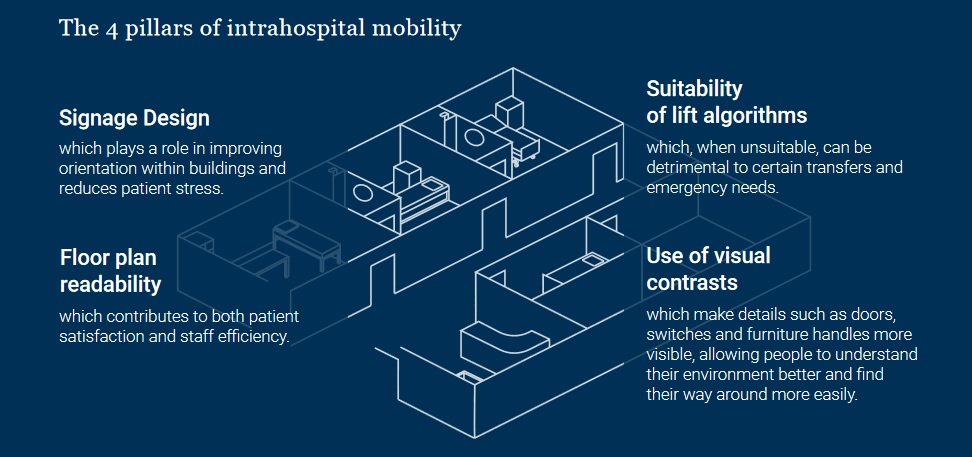Tarkett white paper calls for a new approach to the creation of healthcare environments

The COVID-19 pandemic has disrupted healthcare systems around the world, revealing weaknesses and highlighting opportunities.
And this is particularly evident in health infrastructure, which has had to transform in the past 18 months, with the creation of new facilities to cope with an increasing demand on services, and to provide the segregation needed to ensure the safety of patients and staff.
A rethink of a hospital’s ‘default’ layout, in particular the disposition of the various departments and facilities, can create much-needed flexibility in times of crisis
Now, a new white paper has been published by building product and flooring specialist, Tarkett, which draws on the experience of a panel of 12 international experts to explore how healthcare systems, and the buildings from which services are delivered, can be reinvented so they can handle the many threats we face, while also providing care for increasingly-common chronic ailments.
Informed by the response to the pandemic, and based on extensive research into best-practice design and the global healthcare outlook; the comprehensive 70-page paper, entitled Designing The Hospital of the Future: Challenges and Stakes, highlights the need for a multi-disciplinary collaborative approach to realising a fundamentally-new model for the hospital of the future – one that is human centric, efficient, flexible, and environmentally responsible.
Starting the debate
The paper is being made freely available as a contribution to the debate and is helping to drive forward thinking among healthcare providers, consultants, designers, and suppliers.
it will also be used to guide Tarkett’s own product innovation strategy moving forward.
While calling for greater use of digital solutions, the document also focuses on the built environment.
It states: “Designing for quality of life in medical facilities is a central component of the patient experience.
“This should include the creation of healing spaces that promote privacy and give patients a sense of control over their environment.
“Fostering connections with family and friends is also crucial.”
Efficient and flexible
The report states: “Infrastructural flexibility is essential to a hospital’s ability to adapt to emergency needs while ensuring the quality of non-emergency care.
“A rethink of a hospital’s ‘default’ layout, in particular the disposition of the various departments and facilities, can create much-needed flexibility in times of crisis.
“And taking flexibility into consideration from the start means it can be built into the structure of the hospital, whether that means modular spaces that can be repurposed if necessary, or re-engineering spaces in order to optimise their capacity to receive and treat patients.”
Futureproofing healthcare design will also help the sector to meet tough climate change targets, in particular a reduction in carbon emissions.
Currently, in the UK CO2 emissions from NHS hospitals are greater than the combined emissions of all flights out of Heathrow airport.
The health industry produces 18 million tonnes of CO2 annually, which is 3.2% of all CO2 emissions for the UK as a whole.
Environmentally friendly
The white paper states: “The healthcare sector is fully aware of the critical importance of environmental issues for its infrastructure.
“Yet health professionals and other stakeholders in the healthcare ecosystem have been slower than others to initiate their environmental transition.
“By contributing to a healthier environment, these facilities improve their public image and community perceptions, thus strengthening their societal role.
Too many patients express discomfort with the clinical feel and sense of depersonalisation of hospital environments, whether on the ward or in common areas
“Further, healthcare facilities can have a dual effect on climate change: A direct effect by reducing their own environmental footprint; and an indirect effect by encouraging partners, suppliers, colleagues and patients, etc.
“Thus healthcare facilities can contribute to saving community resources such as water and energy, while also reducing pollution.
The patient experience
“This approach also improves the patient experience by bettering the hospital environment and improving its profile with eco-conscious patients.”
The report proposes three types of environmental initiative that should be considered: improving processes, influencing partners, and optimising patient journeys.”
Improving the environment for patients and staff is another focus area in the report.
It states: “Too many patients express discomfort with the clinical feel and sense of depersonalisation of hospital environments, whether on the ward or in common areas.
“And this discomfort can sometimes have a significant impact on stress levels and mental wellbeing.
“It is therefore important to minimise the feeling of diminishment associated with the hospital stay.”
The creation of clear, calm spaces that respect natural biorhythms; and individual control over things like lighting, temperature, and noise are just two ways in which hospital designers can address this.
“The hospital’s built environment will need to do more than just receive patients and enable the delivery of treatments,” says the white paper.
“It will need to become an integral part of the healthcare system, contributing actively or intelligently to the patient experience.”
Looking to the future
And making hospitals ‘great places to work’ is also critical, with the need to support frontline staff by providing them with dedicated spaces for rest.
The paper concludes: “Just as the COVID-19 pandemic revealed the weaknesses in healthcare systems around the world and created an imperative to address these weaknesses; it also accelerated the adoption of digital health technologies which will facilitate the radical level of change required.
The hospital’s built environment will need to do more than just receive patients and enable the delivery of treatments
“A deeper integration of digital technology, a raising of the bar in standards of sustainability, and an approach that is fundamentally human centred will ensure that the Hospital of the Future delivers high-quality, cost-effective medical care that meets the needs of patients, medical staff, and the wider community, now and for the future.
“Tarkett is committed to playing an active role in this transformation, continuing to innovate and collaborate with the broad spectrum of partners across the global healthcare community to realise together the greatest potential of the Hospital of the Future.”